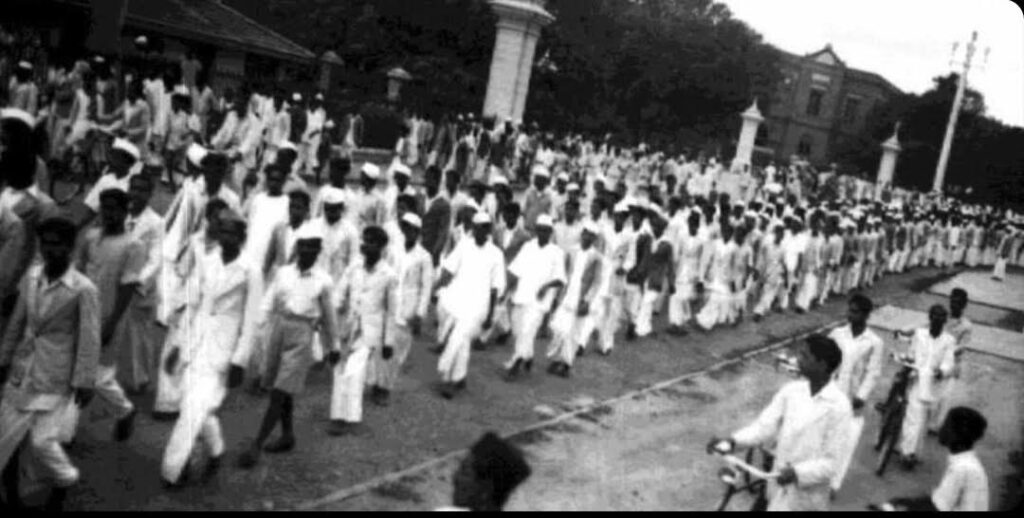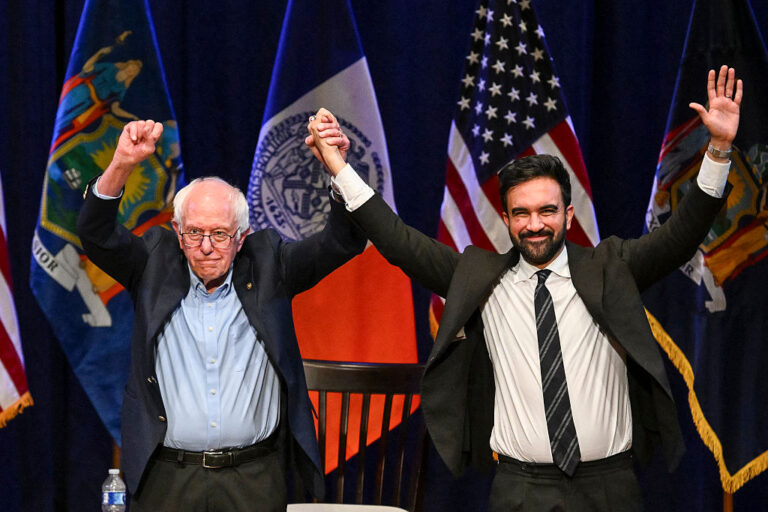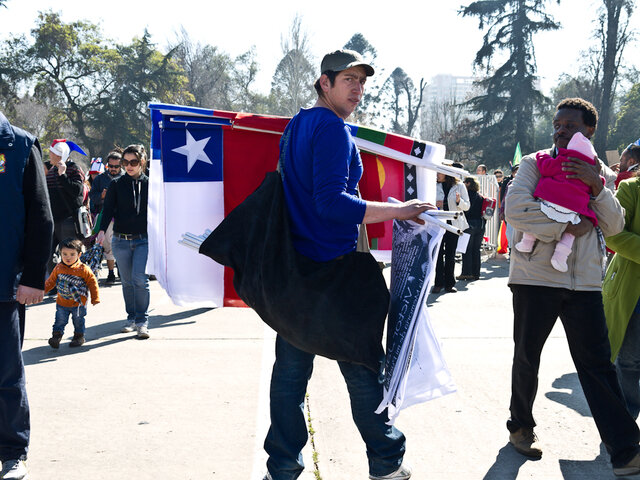
[As the country celebrates its 78th anniversary of independence, we present a series of articles tracing the birth of the nation and it’s current predicament. This article, the first in the series, examines India’s independence, situating 1947 within the broader crises of global imperialism, the shifting balance of class forces, and the strategic calculations of the British state. Moving beyond nationalist hagiography, it interrogates the economic and political compromises that shaped the transfer of power, the role of the native bourgeoisie in limiting the scope of decolonisation, and the missed revolutionary possibilities—particularly in relation to the Communist Party of India’s wartime stance. By linking domestic struggles with geopolitical developments, the piece seeks to reclaim Indian independence as a contested historical process rather than a singular moment of liberation. -ed]
Indian independence in 1947 was a big turning point in contemporary history, as it signalled the end of nearly two centuries of the largest British colonial rule on the planet. This event cannot be reduced to just a political victory for a nation but must be considered as part of the wider global conflict between imperialist powers and oppressed nations, shaped by the relationship between class struggle and development of productive forces. The independence movement created moments of great hope for greater social emancipation, however, that dream remained largely elusive.
The British India was a dependent colony in the capitalist world economy. Towards the end of the 18th century, the economy of the subcontinent was transformed to fit the needs of British businesses. It was a big market for British-made commodities and a source of raw materials and agro-commodities, including cotton, jute, and tea. The colonial policy systematically weakened local industries. According to Karl Marx, “the British intruders broke up the Indian hand-loom and destroyed spinning,” which harmed the self-sustainability of the local economy, making it dependent on British capitalism. Of course, it was never an unintended consequence of British governance but a deliberate reconfiguration of India’s economic dynamics to align with metropolitan capitalist objectives.
Class Forces in the Nationalist Movement
The long fight for India’s independence was not a single movement; it was a coalition of people from different classes and backgrounds with different goals. The Indian National Congress was founded in 1885, and most of its leaders were from the native bourgeoisie and the landed class. Their main goal was to create an independent state that kept strong capitalist property rights and a national market that wasn’t controlled by the British.
By the 1920s, the Indian capitalist class—a relatively small yet influential group comprising industrialists, merchants, bankers, and mill owners—had amassed considerable economic power within the colonial economy. This consolidation was the result of three key historical developments – shifts in colonial policy, the emergence of organised capitalist interests and the rise of nationalist capitalism.
The First World War (1914–1918) presented two major opportunities for the Indian capitalist class. It disrupted British imports into India, creating space for indigenous industrial growth, especially in textiles, jute, iron, and steel. The war also stimulated demands for war supplies, allowing Indian capitalists to accumulate unprecedented profits. According to the historian Bipan Chandra, “wartime disruption of normal trade patterns increased India’s exports of raw materials and foodstuffs.” The British, albeit reluctant, were compelled to rely more heavily on Indian businesses due to wartime shortages.
In the meantime, the Indian bourgoeisie organised itself in various way notably through The Indian Merchants’ Chamber (1907) and later the Federation of Indian Chambers of Commerce and Industry (FICCI) (1927). This gave the bourgeoisie an institutional voice to lobby for tariffs, industrial policy, and greater participation in governance. Leading Indian industrialists like G. D. Birla, Jamnalal Bajaj, and Purshottamdas Thakurdas became both economic and political influencers.
The Indian bourgeoisie aligned themselves with the Indian National Congress (INC), particularly during the famous Non-Cooperation Movement (1920–1922), supporting swadeshi (use of Indian goods) as both a nationalist and profit-driven policy. Although the native bourgeoisie was politically subservient to the British, they established clear dominance in certain sectors. Around the 1920s, Indian-owned mills dominated cotton textiles in Bombay and Ahmedabad and were expanding in jute in Bengal, previously dominated by British capital. The steel plant established by the Tatas in Jamshedpur (Tata Iron and Steel Company) in 1907, became a symbol of industrial self-sufficiency and was the largest steel plant in the British Empire by the mid-1920s. All these developments facilitated their influence over trade policies as the Indian bourgeoisie successfully pushed for protective tariffs (e.g., 1923 cotton duties) to shield domestic industry from British imports.
Their alliance with nationalist politics and their support for Congress gave them political leverage to influence the direction of the independence movement toward goals that served capitalist interests rather than socialist revolution. The hegemony of the Indian bourgeoisie was a class project, and this was nowhere better reflected than in the Congress’ economic programme which aimed for a national independence under capitalism. As we can see, the economic muscle of the Indian bourgeoisie created their political hegemony, allowing them to become the leading class in the national movement, marginalising more radical demands from workers and peasants. Their leadership ensured that the anti-imperialist struggles did not cross the limits and threaten capitalist property relations. It is also true that, at times, they cooperated with sections of the colonial state when it served their interests, for example, accepting British capital in joint ventures and suppressing militant labour unrest.
Despite their growing economic dominance, the native bourgeoisie had a few more miles to go. They were still subjected to structural constraints, as British capital still retained control over finance, shipping, plantations, and also many high-profit sectors, including insurance and banking. Moreover, the colonial state was fundamentally designed to protect imperial interests, and concessions to Indian capitalists were only tactical and never transformative.
In sum, by the 1920s, the Indian bourgeoisie had achieved sectoral dominance in key industries (textiles, steel). Their economic strength facilitated their hegemony over nationalist politics which they adeptly used to advance their class interests thereby shaping the economic agenda of the independence movement toward capitalist development. As a result of their hegemonic position in the anti-colonial bloc, the socialist and working-class alternatives were clearly sidelined.
The situation created around WWI had a great lesson for the Indian bourgeoisie. They understood that they could fairly compete with British capital when given protection and, political power was the key to securing that protection permanently.
Beyond the Bourgeois Narrative
The official histories do not fail to remind us that the Indian National Congress led the fight for freedom and won it in 1947. However, it does not clarify for whom freedom was achieved? What happens to the workers in the mills or the peasants crushed by rent and debt or the toiling masses who shed blood in the streets?
Meanwhile, the Russian Revolution changed the course of human history. It proved that even a vast, backward country could defeat its ruling class and imperialist chains through the united power of workers and peasants. It inspired millions around the world, and in India, a few years later, the communists and socialists took up their role as the class-conscious wing of the freedom struggle. They linked the anti-imperialist fight with the struggle to overthrow capitalism and feudalism. However, long before the Communist Party existed, Indian revolutionaries abroad — the Ghadarites — raised the banner of armed rebellion against the British. Though not yet Marxist, they shared with communists a hatred for colonial exploitation and a belief in international working-class solidarity.
The Communist Party of India (CPI) was formally established in 1925 at Kanpur. From the start, it was rooted in the struggles of workers and peasants, leading strikes in the Bombay textile mills and Bengal jute mills, organising railway workers into militant trade unions, and spreading Marxist literature despite brutal colonial repression. From the onset, the communists were clear that independence under capitalism would not end exploitation. Their aim was a worker–peasant republic.
In 1934, the Congress Socialist Party (CSP) was formed by Jayaprakash Narayan, Acharya Narendra Deva, and others. They tried to push the Congress toward radical land reforms, state-led industrialisation and also, direct action against imperialism. While the CSP often worked with communists in strikes and peasant struggles, their position inside the Congress often tied their hands when the leadership compromised with the British or the bourgeoisie.
Communists and socialists built mass organisations that gave the freedom struggle a militant, working-class edge. The strikes led by the All India Trade Union Congress (AITUC) — shook Bombay, Calcutta, and railway lines across the country. Under the leadership of the All India Kisan Sabha (AIKS) — millions of peasants rose against landlordism, sparking movements like Tebhaga in Bengal, Telangana armed struggle and others. These were not symbolic protests. They were direct challenges to both colonial and landlord–capitalist power.
The Indian communists were indeed among the first to openly and consistently call for complete independence (purna swaraj) from British rule at a time when the Indian bourgeois leadership of the Congress was still vacillating between moderate constitutional reform and dominion status within the British Empire. Until the late 1920s, the mainstream Congress leadership (dominated by moderates and later Gandhi’s “constructive programme” wing) did not demand complete separation from the British Empire. Their demands were generally centred around greater Indian representation in the legislature; dominion status, i.e., self-government within the Empire, like Canada or Australia. The bourgeoisie feared that a full rupture might provoke uncontrollable mass upheavals that could also threaten their own property relations. Even in the 1928 Nehru Report, dominion status was the official goal, despite growing youth and left-wing agitation for full independence.
War Years and Class Contradictions
When WWII broke out, the communists initially opposed it as an inter-imperialist war, i.e., a clash between rival colonial powers for markets and territories. They opposed British war efforts in India, called for militant struggles, and aligned with other anti-colonial forces in strikes, peasant uprisings, and protests. This made the communists part of the broader anti-British coalition, despite their still-limited size.
However, the position changed after Hitler’s invasion of the Soviet Union in 1941. The Comintern line shifted to a People’s War — supporting the Allies against fascism. This led the CPI to abstain from the Quit India Movement in 1942. The action created divisions between communists and other anti-imperialist forces.
For communists worldwide, defeating fascism became the primary task; anti-colonial struggles were now to be subordinated to the Allied war effort. This was the CPI’s “surrender” in the Indian context. In all practicality, it supported the Allied (British) war effort in India — urging workers to avoid strikes that could hinder production for the war. It even worked to maintain industrial peace, a stance that objectively aided British imperialism. During the Quit India Movement of August 1942 — the largest mass uprising against British rule since 1857 — the CPI opposed it, calling it disruptive to the fight against fascism.
Quit India was led mainly by the Congress and spontaneous mass action from below. By refusing to participate — and in some cases actively discouraging strikes and protests — the CPI alienated itself from a large section of the anti-imperialist masses. This move was seen by many nationalists as “betrayal” or “collaboration” with the British.
Before 1941, communists were growing in influence through militant strikes and peasant actions. The new line cooled down this militancy, breaking the link between the CPI and the most militant anti-British currents for nearly three years. This shift meant the CPI ceded the leadership of the mass movement back to the bourgeois-nationalist Congress. The chance to position the working class as the vanguard of the independence struggle was lost, at least temporarily.
From the CPI’s own standpoint, the policy was internationalist loyalty to the Soviet Union, which was under existential threat, but in India, it meant prioritising imperial Britain’s war needs over immediate liberation. While this might be defensible from a global anti-fascist perspective, it weakened the CPI’s domestic anti-imperialist credentials and its ability to challenge bourgeois leadership after 1945.
After the war, the CPI tried to recover revolutionary momentum with the Telangana armed struggle, the Tebhaga movement, and militant strikes, but by then, the Congress had reasserted itself as the primary nationalist force. The communist “surrender” in 1941–45 arguably foreclosed the possibility of a left-led independence in India. Marxist like R. Palme Dutt defend the CPI’s decision as historically necessary for defeating fascism, while others — including some in the Indian left — argue it was a sectarian subordination to Comintern orders that disrupted the organic link between communists and India’s mass anti-colonial upsurge.
It is important to acknowledge that popular leftist organisations, particularly trade unions, significantly contributed to the Quit India movement. Leftist factions from non-CP traditions, such as the RSP, RCPI, BLPI, among others, engaged in the movement with considerable enthusiasm. Also, socialists in the CSP went underground to fight, and after 1945, communists returned to militant mass action — leading strikes, mutinies (Royal Indian Navy Revolt, 1946), and armed peasant uprisings.
The Missed Opportunity and its Results
The CPI’s refusal to join Quit India prevented the working class and peasantry from becoming organised, conscious leaders of the independence movement at a decisive moment. As a result, bourgeois nationalism was able to present 1947 as its victory — shaping the new state to serve capitalist accumulation and preserve landlord power.
The CPI’s withdrawal from the anti-British front in 1942 left the political spaces open for communal forces to expand, though it wasn’t the sole cause. The connection is subtle but very real in terms of class politics and political vacuum.
Although the CPI’s withdrawal didn’t create communalism. British imperial policy and class contradictions in India had already nurtured it, but with the communists away from the anti-imperialist front, a major secular, working-class pole of attraction from the frontlines was removed. Without that pole, the bourgeois–communal divide deepened, and the independence struggle increasingly played out in communal terms rather than class terms. The subcontinent still suffers from this devastating legacy today.
In sum, subordinating a colonial liberation struggle to the foreign policy needs of another state (even a “socialist” one) can break the organic link between revolutionaries and the masses and hand the political initiative back to the bourgeoisie.
The Unfinished Revolution
In the end, the bourgeois leadership of the Congress gegotiated a settlement with British imperialism which left landlordism intact and protected capitalist property. The communists and socialists, despite their heroism, were not in a position to seize national leadership by 1947. Repression, internal debates, and the political strength of the bourgeoisie meant that the revolution was halted mid-way.
1947 shows that political sovereignty can coexist with capitalist exploitation.





Very absorbing history of the Communist Party of India as narrated by Soumya Sahin . This would help to get to know the compulson faced by CPI vis -a -vis Nationalism and Internationalism during first half of last century. However, the failed attempt of achieving Marxist-Leninist revolutions in #Tebhaga,# Telegana#Naxalbari by the leadership of devided Communist parties for theoretical as well as tactical reasons have emasculated the spirit of the masses particularly the peasants,workers and the most marginalized sections of our society. And, thereby all the Rightist,Communal nd Reactionaries have slowly but surely consolidated their strength which may culminate in achieving the #Dream Project of RSS ,a so called #HINDURASHTRA which eventually agument the disintegration of our beloved country beling the great country of different culture/language/Religion with rich heritage.